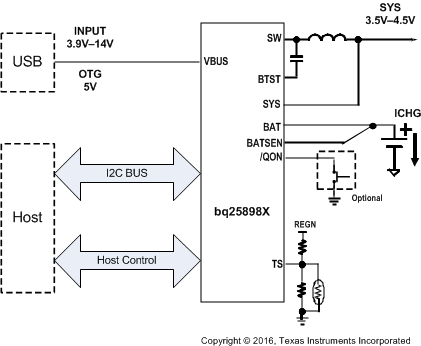ZHCSG50B March 2016 – March 2017
PRODUCTION DATA.
- 1 特性
- 2 应用
- 3 说明
- 4 修订历史记录
- 5 说明 (续)
- 6 Device Comparison Table
- 7 Pin Configuration and Functions
- 8 Specifications
-
9 Detailed Description
- 9.1 Functional Block Diagram
- 9.2
Feature Description
- 9.2.1 Device Power-On-Reset (POR)
- 9.2.2 Device Power Up from Battery without Input Source
- 9.2.3 Device Power Up from Input Source
- 9.2.4 Input Current Optimizer (ICO)
- 9.2.5 Boost Mode Operation from Battery
- 9.2.6 Power Path Management
- 9.2.7 Battery Charging Management
- 9.2.8 Battery Monitor
- 9.2.9 Status Outputs (PG, STAT, and INT)
- 9.2.10 BATFET (Q4) Control
- 9.2.11 Current Pulse Control Protocol
- 9.2.12 Input Current Limit on ILIM
- 9.2.13 Thermal Regulation and Thermal Shutdown
- 9.2.14 Voltage and Current Monitoring in Buck and Boost Mode
- 9.2.15 Battery Protection
- 9.2.16 Serial Interface
- 9.3 Device Functional Modes
- 9.4 Register Map
- 10Application and Implementation
- 11Power Supply Recommendations
- 12Layout
- 13器件和文档支持
- 14机械、封装和可订购信息
1 特性
- 高效率 4A、1.5MHz 开关模式降压充电器
- 充电效率高达 92%(3A 充电电流下)和 91%(4A 充电电流下)
- 针对高电压输入 (9V/12V) 进行了优化
- 低功耗 PFM 模式,适用于轻负载操作
- USB On-the-Go (OTG),可调输出电压范围为 4.5V 至 5.5V
- 单个输入,支持 USB 输入和可调高压适配器
- 支持 3.9V 至 14V 输入电压范围
- 输入电流限制(100mA 至 3.25A,分辨率为 50mA),支持 USB2.0、USB3.0 标准和高压适配器
- 通过输入电压限制(最高 14V)实现最大功率跟踪,适用于各类适配器
- 自动检测 USB SDP、CDP、DCP 以及非标准适配器 (bq25898)
- 可编程的 D+/D- 驱动器,用于非标准适配器握手
- 远程电池感测
- 输入电流优化器 (ICO),无需过载适配器即可最大限度提高输入功率
- 充电器输出与电池终端间的电阻补偿 (IRCOMP)
- 借助 5mΩ 电池放电金属氧化物半导体场效应晶体管 (MOSFET) 实现最高电池放电效率,放电电流高达 9A
- 集成 ADC,用于系统监视
(电压、温度和充电电流) - 窄 VDC (NVDC) 电源路径管理
- 与无电池或深度放电电池工作时可瞬时接通
- 电池管理模式中的理想二极管运行
- BATFET 控制,支持运输模式、唤醒和完全系统复位
- 灵活的自主和 I2C 模式,可实现最优系统性能
- 高集成度,包括所有 MOSFET、电流感测和环路补偿
- 12μA 低电池泄漏电流,支持运输模式
- 高精度
- ±0.5% 充电电压调节
- ±5% 充电电流调节
- ±7.5% 输入电流调节
- 安全
- 用于充电模式和升压模式的电池温度感测
- 热调节和热关断
- 采用 2.8mm x 2.5mm 42 焊球芯片尺寸球状引脚栅格阵列 (DSBGA) 封装
2 应用
- 智能手机
- 平板电脑
- 便携式网络设备
3 说明
bq25898 和 bq25898D 是适用于锂离子电池和锂聚合物电池的高度集成型 4A 开关模式电池充电管理和系统电源路径管理器件。该器件支持高输入电压快速充电。
器件信息(1)
| 器件型号 | 封装 | 封装尺寸(标称值) |
|---|---|---|
| bq25898 | DSBGA (42) | 2.80mm x 2.50mm |
| bq25898D | DSBGA (42) | 2.80mm x 2.50mm |
- 如需了解所有可用封装,请参阅数据表末尾的可订购米6体育平台手机版_好二三四附录。
简化电路原理图

4 修订历史记录
Changes from A Revision (December 2016) to B Revision
- 完整数据表已更新到米6体育平台手机版_好二三四文件夹 Go
Changes from * Revision (March 2016) to A Revision
- Changed 已在特性中将 93% 更改为 94% Go
- Changed anode to cathode in BTSTGo
- Changed cathode to anode in REGNGo
- Changed falling to rising in tACOV_RISING test conditions in Electrical CharacteristicsGo
- Deleted USB SDP (USB100) and the OTG Pin column from Table 3 and Table 4Go
- Changed VREF to VREGN in Equation 2 Go
- Changed VREF to VREGN in Figure 18 Go
- Changed 260 Ω to 232 Ω in Input Current Limit on ILIM Go
- Added note to Figure 49 Go